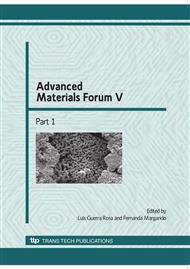[1]
Runeman, B. et al, The vulva skin microclimate, Acta Derm-Vener, Vol. 83, No. 2, p.8892, (2003).
Google Scholar
[2]
Geiger, A. M., Foxman, B., Risk factors for vulvo-vaginal candidiasis: a case-control study among university students, Epidemiology, Vol. 7, pp.182-187, (1996).
DOI: 10.1097/00001648-199603000-00013
Google Scholar
[3]
Runeman, B. et al, The Vulvar Skin Microenvironment, Acta Derm Venereol, Vol. 85, pp.118-122, (2005).
Google Scholar
[4]
Mardh, P. -A., Nokova, N., Stukalova, E., Colonisation of external sites by Cândida in women with recurrent vulvovaginal candiosis, BJOG: International Journal of Obstetric and Gynaecology, Vol. 110, pp.934-937, (2003).
DOI: 10.1111/j.1471-0528.2003.01445.x
Google Scholar
[5]
Per-Anders M. et al, Colonization of extragenital sites by Candida in women with recurrent vulvo-vaginal candidosis, Int. J. of Obst. Gynaec., Vol. 110, pp.934-937, (2003).
Google Scholar
[6]
Mardh, P.A. et al, Facts and myths on recurrent vulvo-vaginal candidosis - a review on epidemiology, clinical manifestations, diagnosis, pathogenesis and therapy, Int. Journal of STD & AIDS, Vol. 13, pp.522-539, (2002).
DOI: 10.1258/095646202760159639
Google Scholar
[7]
Foxman, B., The Epidemiology of Vulvovaginal Candidiasis: Risk Factors, Am J Public Health, Vol. 80, pp.329-331, (1990).
DOI: 10.2105/ajph.80.3.329
Google Scholar
[8]
Farage, M. A. et al, Labial and Vaginal Microbiology: Effects of Extended Panty Liner Us, e, Infectious Diseases in Obst. and Gyneo., Vol. 5, pp.252-258, (1997).
DOI: 10.1002/(sici)1098-0997(1997)5:3<252::aid-idog11>3.0.co;2-a
Google Scholar
[9]
Runeman, B. et al, The Vulva Skin Microenvironment, Acta Derm Venereol, Vol. 84, pp.277-284, (2004).
Google Scholar
[10]
Renbourn, E. T., Rees, W. H., Materials and Clothing in Health and Disease. History, Physiology and Hygiene, Merrow, (1972).
Google Scholar
[11]
Faro S.; Vaginitis: Diagnosis and management, International Journal of Fertility and Menopausal Studies, Vol. 42, No. 2, pp.115-123, (1996).
Google Scholar
[12]
Schafer, P., Bewick-Sonntag, C., Capri, M. G., Berardesca E.; Physiological changes in skin barrier function in relation to occlusion level, exposure time and climatic conditions, Skin Pharm and Appl Skin Physi, Vol. 15, No. 1, pp.7-19, (2002).
DOI: 10.1159/000049384
Google Scholar
[13]
Ossowski, B. et al, Disinfecting treatment of textiles to prevent reinfection in vulvovaginal candidiasis, Gebur. und Frauenheil., Vol. 59, No. 4, pp.175-179, (1999).
Google Scholar
[14]
Wilkoff, L. J., Westbrook, L., Dixon, G. J., Factors Affecting the Persistence of Staphylococcus aureus on Fabrics, Applied Microbiology, pp.268-274, (1969).
DOI: 10.1128/am.17.2.268-274.1969
Google Scholar
[15]
Yuehuei, H., Friedman, R. J., Handbook of Bacterial Adhesion: Principles, Methods and Applications, Human Press, (2000).
Google Scholar
[16]
An, Y. H., Friedman, R. J., Concise Review of Mechanisms of Bacterial Adhesion to Biomaterial Surfaces, Journal of Biomedical Materials Research (Applied Biomaterials), Vol. 43, pp.338-348, (1998).
DOI: 10.1002/(sici)1097-4636(199823)43:3<338::aid-jbm16>3.0.co;2-b
Google Scholar
[17]
Pan, N., Gibson, P., Thermal and moisture transport in fibrous materials, Woodhead Publishing Limited, 1st Edition, (2006).
Google Scholar
[18]
Patnaik, A. et al, Wetting and Wicking in Fibrous Materials, The textile Institute - Textile Progress, Woodhead Publishing Limited, Vol. 38, No. 1, (2006).
DOI: 10.1533/jotp.2006.38.1.1
Google Scholar
[19]
Holmberg, K., Handbook of Applied Surface a Colloid Chemistry - Volume 2, John Wiley & Sons, (2002).
Google Scholar
[20]
Morgan, T. D., Wilson, M., The effects of surface roughness and type of denture acrylic on biofilm formation by Streptococcus oralis in a constant depth film fermentor, J. of Appl. Microb, Vol. 91, pp.47-53, (2001).
DOI: 10.1046/j.1365-2672.2001.01338.x
Google Scholar


